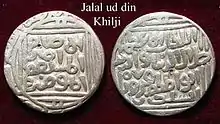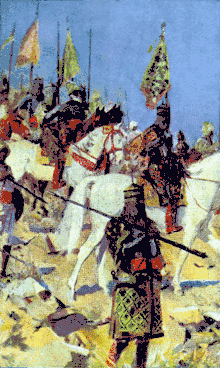Khalaj people
The Khalaj (Bactrian χαλασσ Xalass; Pashto: خلجیان, romanized: Khalajyān; Persian: خلجها, romanized: Xalajhâ) are classified as a Turkic tribe.[2] Medieval Muslim scholars considered the tribe to be one of the earliest to cross the Amu Darya from Central Asia into present-day Afghanistan. The Khalaj were described as sheep-grazing nomads in Ghazni, Qalati Ghilji, and the surrounding districts, who had a habit of wandering through seasonal pastures.
._Crowned_bust_right._Shiva_standing_facing%252C_holding_trident%252C_to_left_%CF%87%CE%B1%CE%BB%CE%B1%CE%B3%CE%B3_or_%CF%87%CE%B1%CE%BB%CE%B1%CF%83%CF%83_in_Bactrian.jpg.webp)
In Iran, they still speak Khalaj language, which is classified as Turkic, although most of them are Persianized.[3] In Afghanistan, the Ghilji tribe of Pashtuns likely descends from the Khalaj people.[4][5]
Etymology
According to linguist Gerhard Doerfer, Mahmud al-Kashgari was the first person mentioning the Khalaj people in his Dīwān Lughāt al-Turk:
- "The twenty twos call them "Kal aç" in Turkic languages. This means "Stay hungry". Later, they were called "Xalaj"."[6]
- "Oguzs and Kipchaks translate "x" to k". They are a group of "Xalaj". They say "xızım", whereas Turks say "kızım" (my daughter). And again other Turks say "kande erdinğ", whereas they say "xanda erdinğ", this means "where were you?" [7]
Turkologist Yury Zuev stated that *Qalaç resulted from *Halaç, owing to the sound-change of prothetic *h- to *q-, typical in many medieval Turkic dialects, and traced Halaç's etymology back to ala, alač, alaça "motley, piebald".[8]
However, according to historian V. Minorsky, the ancient Turkic form of the name was indeed Qalaj (or Qalaç), but the Turkic /q/ changed to /x/ in Arabic sources (Qalaj > Xalaj). Minorsky added: "Qalaj could have a parallel form *Ğalaj." This word yielded Ğəljī in Pashto, which was used for the Pashtun Ghilji tribe centered around Ghazni and Qalati Ghilji.[5]
Origin

Ilhanate's statesman and historian Rashid-al-Din Hamadani mentions the Khalaj tribe in his 14th century Jami' al-tawarikh as part of the Oghuz (Turkmen) people:
"Over time, these peoples were divided into numerous clans, [and indeed] in every era [new] subdivisions arose from each division, and each for a specific reason and occasion received its name and nickname, like the Oghuz, who are now generally called the Turkmens [Turkman], they are also divided into Kipchaks, Kalach, Kanly, Karluk and other tribes related to them ".[9]
However, some historians, including 10th-century al-Khwarizmi and 20th-century Josef Markwart, consider the Khalaj to be remnants of the Hephthalite confederacy.[10]
The Khalaj might have later been incorporated into the Western Turkic khaganate, as Hèluóshī (賀羅施), mentioned besides Türgesh (Tūqíshī 突騎施),[11] before regaining independence after the collapses of the Western Turkic and the Türgesh khaganates. Groups of the Khalaj people migrated into Persia beginning with the invasions of the Seljuq Turks, during the 11th century. From there, a branch of them migrated to the Azerbaijan region, where they supposedly picked up greater Oghuz influence in their language. However, the Khalaj are very few among Iranian Azerbaijanis today. Sometime shortly prior to the time of Timur (1336-1405), a branch of Khalaj migrated to the area southwest of Saveh in the Markazi Province, which is where a large branch of the Khalaj are located today.[10] However, today, the Khalaj people also identify as Persians despite still speaking their local Turkic language. This is due to undergoing processes of Persianization starting in the mid 20th century.[3]
Discussing their relationship with Karluks, Minorsky and Golden noted that the Khalaj and Karluks were often confused by medieval Muslim authors, as their names were transcribed almost similarly in Arabic.[12] Even so, Kitāb al-Masālik w’al- Mamālik's author Ibn Khordadbeh distinguished Khalajs from Karluks, though he mentioned that both groups lived beyond the Syr Darya of the Talas; Muhammad ibn Najib Bakran wrote in his Jihān-nāma (c. 1200-20) that "by mistake (in writing) the people called the Khallukh Khalaj."[13]
History


Medieval Muslim scholars, including 9th-10th century geographers Ibn Khordadbeh and Istakhri, narrated that the Khalaj were one of the earliest tribes to have crossed the Amu Darya from Central Asia and settled in parts of present-day Afghanistan, especially in the Ghazni, Qalati Ghilji (also known as Qalati Khalji), and Zabulistan regions. Mid-10th-century book Hudud al-'Alam described the Khalaj as sheep-grazing nomads in Ghazni and the surrounding districts, who had a habit of wandering through seasonal pastures.
11th-century book Tarikh Yamini, written by al-Utbi, stated that when the Ghaznavid Emir Sabuktigin defeated the Hindu Shahi ruler Jayapala in 988, the Khalaj and Pashtuns (Afghans) between Laghman and Peshawar, the territory he conquered, surrendered and agreed to serve him. Al-Utbi further stated that Khalaj and Pashtun tribesmen were recruited in significant numbers by the Ghaznavid Sultan Mahmud of Ghazni (999–1030) to take part in his military conquests, including his expedition to Tokharistan.[14] The Khalaj later revolted against Mahmud's son Sultan Mas'ud I of Ghazni (1030–1040), who sent a punitive expedition to obtain their submission. In 1197, Muhammad bin Bakhtiyar Khalji, a Khalaj general from Garmsir, Helmand in the army of the Ghurid Sultan Muhammad of Ghor, captured Bihar in India, and then became the ruler of Bengal, beginning the Khalji dynasty of Bengal (1204-1227). During the time of the Mongol invasion of Khwarezmia, many Khalaj and Turkmens gathered in Peshawar and joined the army of Saif al-Din Ighraq, who was likely a Khalaj himself. This army defeated the petty king of Ghazni, Radhi al-Mulk. The last Khwarazmian ruler, Jalal ad-Din Mingburnu, was forced by the Mongols to flee towards the Hindu Kush. Ighraq's army, as well as many other Khalaj and other tribesmen, joined the Khwarazmian force of Jalal ad-Din and inflicted a crushing defeat on the Mongols at the 1221 Battle of Parwan. However, after the victory, the Khalaj, Turkmens, and Ghoris in the army quarreled with the Khwarazmians over the booty, and finally left, soon after which Jalal ad-Din was defeated by Genghis Khan at the Battle of the Indus and forced to flee to India. Ighraq returned to Peshawar, but later Mongol detachments defeated the 20,000–30,000 strong Khalaj, Turkmen, and Ghori tribesmen who had abandoned Jalal ad-Din. Some of these tribesmen escaped to Multan and were recruited into the army of the Delhi Sultanate.[15] Jalal-ud-din Khalji (1290-1296), who belonged to the Khalaj tribe from Qalati Khalji, founded the Khalji dynasty, which replaced the Mamluks and became the second dynasty to rule the Delhi Sultanate. 13th-century Tarikh-i Jahangushay, written by historian Ata-Malik Juvayni, narrated that a levy comprising the "Khalaj of Ghazni" and Pashtuns were mobilized by the Mongols to take part in a punitive expedition sent to Merv in present-day Turkmenistan.[5]
Transformation of the Afghan Khalaj
The Khalaj were sometimes mentioned alongside Pashtun tribes in the armies of several local dynasties, including the Ghaznavids (977–1186).[16] Many of the Khalaj of the Ghazni and Qalati Ghilji region became assimilated into the local Pashto-speaking population and they likely formed the core of the Pashtun Ghilji tribe.[4] They intermarried with the local Pashtuns and adopted their manners, culture, customs, and practices, also bringing their customs and culture to India where they established the Khalji dynasty of Bengal (1204–1227) and the Khalji dynasty of Delhi (1290–1320).[17] Minorsky noted: "In fact, there is absolutely nothing astonishing in a tribe of nomad habits changing its language. This happened with the Mongols settled among Turks and probably with some Turks living among Kurds."[5] Because of their language shift and Pashtunization, the Khalaj were treated as Pashtuns (Afghans) by the Turkic nobles of the Delhi Sultanate (1206–1526).[18][19][20]
Just before the Mongol invasion, Najib Bakran's geography Jahān Nāma (c. 1200-1220) described the transformation that the Khalaj tribe was going through:
The Khalaj are a tribe of Turks who from the Khallukh limits migrated to Zabulistan. Among the districts of Ghazni there is a steppe where they reside. Then, on account of the heat of the air, their complexion has changed and tended towards blackness; the tongue too has undergone alterations and become a different language.
— Najib Bakran, Jahān Nāma
Notable people from the Khalaj tribe
- Muhammad bin Bakhtiyar Khalji, founder of the Khalji dynasty of Bengal (d. 1206)
- Shiran Khalji, second Khalji governor of Bengal (d. 1208)
- Ali Mardan Khalji, rebel Khalji governor of Bengal (d. 1212)
- Iwaz Khalji, third Khalji governor of Bengal (d. 1227)
- Malik Balkha Khalji, final Khalji governor of Bengal (d. 1231)
- Jalal-ud-din Khalji, founder of the Khalji dynasty of Delhi (d. 1296)
- Alauddin Khalji, most powerful Sultan of the Khalji dynasty of Delhi (d. 1316)
- Qutbuddin Mubarak Shah, Sultan of Delhi (d. 1320)
See also
References
- ALRAM, MICHAEL (2014). "From the Sasanians to the Huns New Numismatic Evidence from the Hindu Kush". The Numismatic Chronicle (1966-). 174: 279. ISSN 0078-2696.
- "Enver Konukçu, Halaç (in Turkish)". "Al-Masudi saying that they were of Turkic origin. Istakhri says that they have lived between India and Sijistan since ancient times and that they are Turkic in shape, dress, language. Ibn Khordadbeh introduces them as a Turkic tribe living near the Karluks in the steppes of Central Asia. Muhammad ibn Ahmad al-Khwarizmi saying that they were of White Hun origin."
- "ḴALAJ ii. Ḵalaji Language" - Encyclopaedia Iranica, September 15, 2010 (Michael Knüppel)
- Pierre Oberling (15 December 2010). "ḴALAJ i. TRIBE". Encyclopaedia Iranica. Retrieved 4 July 2020.
Indeed, it seems very likely that [the Khalaj] formed the core of the Pashto-speaking Ghilji tribe, the name [Ghilji] being derived from Khalaj.
- The Khalaj West of the Oxus, by V. Minorsky: Khyber.ORG. Archived June 13, 2011, at the Wayback Machine; excerpts from "The Turkish Dialect of the Khalaj", Bulletin of the School of Oriental Studies, University of London, Vol 10, No 2, pp 417-437 (retrieved 10 January 2007).
- Divanü Lügat-it – Türk, translation by Atalay Besim, TDK Press 523, Ankara, 1992, Volume III, page 415
- Divanü Lügat-it – Türk, translation by Atalay Besim, TDK Press 523, Ankara, 1992, Volume III, page 218
- Zuev, Yu. A. (2002) Early Türks: Sketches of history and ideology, Almaty. p. 144
- Hamadani, Rashid-al-Din (1952). "Джами ат-Таварих (Jami' al-tawarikh)". USSR Academy of Sciences.
- "ḴALAJ i. TRIBE" - Encyclopaedia Iranica, December 15, 2010 (Pierre Oberling)
- Stark, Sören. "Türgesh Khaganate, in: Encyclopedia of Empire, ed. John M. McKenzie et al. (Wiley Blackwell: Chichester/Hoboken 2016)". Cite journal requires
|journal=(help) - Golden, Peter B. (1992). An Introduction to the History of the Turkic People. Otto Harrassowitz, Wiesbaden. p. 387
- Minorsky, V. "Commentary" on "§15. The Khallukh" and "§24. Khorasian Marches" in Ḥudūd al'Ālam. Translated and Explained by V. Minorsky. pp. 286, 347-348
- R. Khanam, Encyclopaedic ethnography of Middle-East and Central Asia: P-Z, Volume 3 - Page 18
- Chormaqan Noyan: The First Mongol Military Governor in the Middle East by Timothy May
- The Pearl of Pearls: The Abdālī-Durrānī Confederacy and Its Transformation under Aḥmad Shāh, Durr-i Durrān by Sajjad Nejatie. https://tspace.library.utoronto.ca/handle/1807/80750.
- Marshall Cavendish (2006). World and Its Peoples: The Middle East, Western Asia, and Northern Africa. Marshall Cavendish. p. 320. ISBN 0-7614-7571-0:"The members of the new dynasty, although they were also Turkic, had settled in Afghanistan and brought a new set of customs and culture to Delhi."
- Ashirbadi Lal Srivastava (1966). The History of India, 1000 A.D.-1707 A.D. (Second ed.). Shiva Lal Agarwala. p. 98. OCLC 575452554:"His ancestors, after having migrated from Turkistan, had lived for over 200 years in the Helmand valley and Lamghan, parts of Afghanistan called Garmasir or the hot region, and had adopted Afghan manners and customs. They were, therefore, wrongly looked upon as Afghans by the Turkish nobles in India as they had intermarried with local Afghans and adopted their customs and manners. They were looked down as non Turks by Turks."
- Abraham Eraly (2015). The Age of Wrath: A History of the Delhi Sultanate. Penguin Books. p. 126. ISBN 978-93-5118-658-8:"The prejudice of Turks was however misplaced in this case, for Khaljis were actually ethnic Turks. But they had settled in Afghanistan long before the Turkish rule was established there, and had over the centuries adopted Afghan customs and practices, intermarried with the local people, and were therefore looked down on as non-Turks by pure-bred Turks."
- Radhey Shyam Chaurasia (2002). History of medieval India: from 1000 A.D. to 1707 A.D. Atlantic. p. 28. ISBN 81-269-0123-3:"The Khaljis were a Turkish tribe but having been long domiciled in Afghanistan, had adopted some Afghan habits and customs. They were treated as Afghans in Delhi Court. They were regarded as barbarians. The Turkish nobles had opposed the ascent of Jalal-ud-din to the throne of Delhi."
